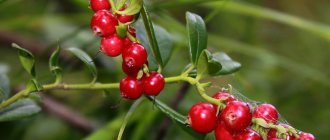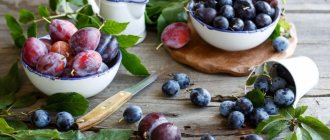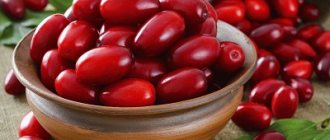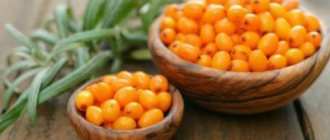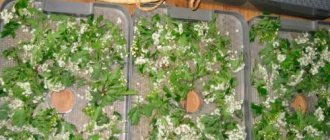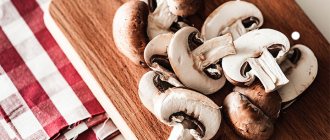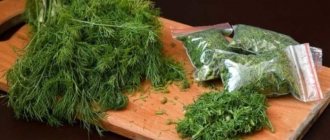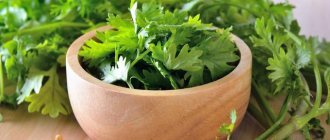Lingonberries soaked with apples
To prepare you will need:
- 1 kg of lingonberries;
- 5 glasses of water;
- 500 g Chinese apples;
- 3 cups granulated sugar.
Preparation:
- Wash the lingonberries and place in a prepared container (alternating with thoroughly washed apples).
- Pour all this over the prepared and completely cooled syrup.
- Then everything is done in the same way as when soaking one lingonberry.
- Instead of Chinese apples, you can take any other apples (Antonov apples are best), which are cut in half before cooking.
- To add flavor, you can use lemon zest or cloves with cinnamon. The syrup is boiled with these spices, then it needs to be strained.
How to freeze lingonberries for the winter
The easiest way to preserve berries is to freeze them in the refrigerator. There are a couple of options on how to do this:
1) Freeze whole berries.
Naturally, before cooking it is necessary to wash the berries and remove excess debris. Next, place the berries on a baking sheet in a thin layer and cover with cling film. Put it in the freezer. When the berries are frozen, they can be moved to a bag or container for convenience.
2) Make a puree of berries with sugar.
Freezing lingonberries in the form of puree is a very convenient option for use in baking. To do this, pour the washed berries into a blender. Add sugar in different quantities. Then grind it to a porridge state. Transfer the resulting mass into jars and place in the freezer.
How to freeze lingonberries with sugar for the winter
You can freeze both whole lingonberries and grated lingonberries with or without sugar. This freezing option is suitable for you if you plan to prepare lingonberry sauce or dessert with berries. It is most convenient to freeze lingonberries with sugar in portions - in an ice tray.
Grind the washed lingonberries using a submersible blender or in a meat grinder. If desired, pass through a sieve to remove skins. After this, if you want to freeze sweet ground lingonberries, add powdered sugar or sugar in a ratio of 1 to 2 (1 part sugar to 2 parts lingonberries) or 1 to 3. If you add sugar, beat the lingonberry puree until the sugar is completely dissolved. To preserve all the beneficial properties of the berry as much as possible, there is no need to cook lingonberries with sugar before freezing. Place the lingonberry puree into an ice tray and place it in the freezer. Lingonberries with sugar can be stored in the freezer for approximately one year.
Preparation
Freezing a berry does not mean simply placing it in the freezer. There are several rules for preparing for storage.
It is necessary to select only ripe fruits. In some cases, if culinary processing is planned after defrosting, for example, a filling from frozen berries or compotes will be prepared, then you can take the fruits at the initial stage of ripening. They will also retain valuable vitamins. For example, a layer pie with frozen berries in winter would not be bad.
Under no circumstances should you store overripe, damaged or rotten fruits.
It is advisable to place in the freezer a product that was collected no later than 2 hours ago. In this case, it will be of high quality. This is most likely only possible if you have your own garden plot or dacha.
At the first stage, they get rid of:
- stalk;
- leaves;
- seed nests.
Care must be taken with soft berries - strawberries, raspberries, blackberries, so as not to damage them during mechanical processing. In some cases, you can freeze berries with the stems, and peel them after defrosting.
Before moving to the freezer, the fruits must be washed and dried. To do this, they are laid out on paper towels. To ensure quick drying, place another towel on top to remove excess moisture.
Methods and rules for freezing lingonberries
Before harvesting fruits for the winter at home, you should remember that they are bitter. It is neutralized by adding sugar, this will improve the taste and reduce the acidity level.
See also
Recipes for preparing blueberries for the winter, how to freeze them in the freezer or grind them with sugar and preserve all the vitamins
Read
In portioned packages
Harvesting occurs in stages:
- The berries are sorted, cleaned of stalks, leaves, and spoiled specimens.
- Wash in cold water and dry.
- Place in portioned bags, seal tightly, and place in the freezer.
The berries are placed in a bag in one layer - this saves space in the freezer compartment.
Grind with sugar
In this option, the berries are frozen with the addition of sugar. To prepare the preparation you need to stock up on:
- lingonberries 1 kg;
- sugar 0.5 kg.
Preparation of the workpiece involves the following steps:
- The washed, dried fruits are poured into a container and covered with sugar.
- The mixture is crushed using a meat grinder/blender to a paste.
- Berry puree is poured into a storage container.
The container is hermetically sealed and placed in the freezer.
Whole berries
You can freeze lingonberries whole - this will preserve more vitamins, organic acids, and minerals:
- It is recommended to use only whole, ripe berries.
- They are washed, dried, and placed in containers.
- The workpiece is placed in the freezer section.
If the fruits are not dry enough, they are frozen in stages. They are laid out in one layer on a tray and placed in the freezer. After freezing, the berries are taken out, poured into a bag, and put back in the cold.
Preparations in syrup
To prepare you need to stock up:
- water 1 l;
- granulated sugar 2-3 tbsp. l.;
- salt 0.5 tsp.
How to cook:
- The fruits are washed and placed in a bottle.
- Boil syrup with water, salt and sugar in a saucepan. You can add a spicy, piquant taste to the berries with cloves and cinnamon.
- The syrup is boiled over low heat for 10-15 minutes and poured into a bottle.
After cooling, the workpiece is stored in the refrigerator.
How to use basil? Is it added when pickling cucumbers?
How to use basil? Is it added when pickling cucumbers? SOURCE
Basil (regan)
Sweet basil or garden basil is an annual herbaceous plant with a pleasant balsamic aroma, belonging to the Lamiaceae family. The botanical name can be translated as “fragrance worthy of kings.” Basil is native to South Asia. It grows wild in Iran, China, Africa, tropical America, Central Asia, the Caucasus, etc. This plant can simply be grown in boxes on a windowsill. The spice is the leaves (purple and green) and flowers collected at the beginning of flowering. The taste of basil is slightly bitter with a sweetish aftertaste. It is an aromatic plant with a spicy odor, some species of which resemble cloves or nutmeg in smell. Most varieties of basil have green leaves, but there are also purple basil, lemon basil and cinnamon basil. The last two are so named because of the corresponding aroma. Basil also differs in smell: Yerevan has bluish leaves with the aroma of allspice and tea; Baku has brownish-purple leaves with a clove-minty aroma; Spoon-shaped with light green leaves, it has a scent of cloves and bay leaves. Basil is a key herb in Mediterranean cuisine (it is used to make Italian pesto sauce) and is becoming increasingly popular in the cuisines of other countries.
Preparation and storage There are several ways to preserve fresh basil for several days.
1. Wrap the basil leaves in a paper towel, place them in a plastic bag and place them in the refrigerator.
2. You can place basil sprigs in a glass of water, base down (that is, in the direction of growth), and cover the upper part (leaves) with plastic. The water must be changed every 2 days. In this way, basil can be kept fresh for up to 7 days.
3. Alternatively, the basil should be washed well, dried, and placed in a tightly closed container, first sprinkled with salt.
4. Alternatively, you can chop the basil leaves finely and add a little olive oil.
Dried basil has a faint aroma. It can be stored in a dry, dark place for up to 6 months.
Use in cooking
Basil is added to lamb, beef, offal and poultry dishes, pasta dishes, salads, pates, soups, sauces, as well as minced meat, liver dishes, fish and cheese. It perfectly complements all second vegetable dishes of beans, peas, beans, tomatoes, spinach and sauerkraut.
A pinch of basil will add an exotic taste to scrambled eggs, cottage cheese and yogurt. In canning, it is added for flavor in pickles (tomatoes, cucumbers, squash, porcini mushrooms), when sauerkraut, pickling eggplants and bell peppers, in marinades, tomato sauces, and sausages. In Azerbaijan, drinks are flavored with seeds, and tea is used in Uzbekistan.
A mixture of basil and rosemary acquires a peppery smell, and with savory it enhances the spiciness of the dish. Basil goes well with marjoram, parsley, coriander, mint, and tarragon.
It is added to soups, stewed, boiled and fried dishes 10-15 minutes before readiness, and to minced meat during cooking. You can make your own wonderful basil vinegar for salads: to do this, pour fresh basil leaves with warm wine vinegar and leave in a closed bottle for two weeks. A deliciously aromatic salad oil can be created by crushing fresh leaves with olive oil in a porcelain bowl.
Other basics of eating lingonberries
Before consuming lingonberries, you should learn the basics of their preparation and other features. The following important points are highlighted here:
- Where do lingonberries grow? As a rule, the presented plant grows in shaded areas. In Russia, a large number of bushes can be found in the taiga or forest areas where lowlands predominate. It is necessary to collect berries at the end of summer, beginning of autumn. At this time, the berries are ripe and acquire their sweet and sour taste.
- How to store lingonberries at home? This may be surprising, but lingonberries can last in the refrigerator for no more than 5-6 days. Therefore, most housewives simply freeze berries for the winter and use them as needed or natural needs.
- Do lingonberries lower blood pressure or increase it? The presented berries, like natural honey, normalize blood pressure. As a result, if you experience headaches, do not rush to get a blood pressure monitor. Just eat a tablespoon of fresh or thawed berries.
An important question for everyone remains which is healthier: cranberries or lingonberries. This question arises quite rightly, because the taste of these berries is similar, they grow in the same conditions.
The differences between cranberries and lingonberries are insignificant, so you can consume both berries in equal quantities. But it should be remembered that cranberries are prohibited for consumption by people with low blood pressure, since, unlike lingonberries, this berry actually reduces this indicator. Therefore, you should not overuse cranberries.
– rate the article, 4.48 / 5 (number of votes – 66)
HealFolk.ru
How to defrost lingonberries before eating
How lingonberries will look depends not only on the correct freezing and storage, but also on the defrosting method. This can be done in at least three ways, but only one of them will keep it intact and not wrinkled.
It is best to remove the lingonberries from the freezer and place them in the refrigerator. There it will defrost gradually over 5-8 hours. At the same time, it will not let in the juice and its appearance and beneficial properties will be preserved as much as possible.
If you need to defrost the berries faster, this can be done at room temperature. Under such conditions, they will be ready for consumption in 1-3 hours or faster, depending on the quantity. The disadvantage of this method is that lingonberries release a lot of juice.
Due to the release of juice during rapid defrosting, the taste of the fruit may change slightly.
For the fastest defrosting, berries can be placed in the microwave. It is worth considering that they will not only release juice and lose their appearance, but will also lose some of their beneficial properties.
How to defrost correctly
Methods that allow you to properly defrost berries:
- In the microwave in the “Defrost” mode. You will need to check every minute how the product is defrosting so that the lingonberries do not heat up. This method leads to the destruction of the beneficial elements of the berry.
- Defrosting at room temperature is a slow process; the berries release a lot of juice, which also leads to the proliferation of microbes.
- The fruit in the bag is placed under running water - this method is very fast, but getting water into the lingonberry will lead to it becoming soggy and watery.
The best defrosting option is to place it on the top section of the refrigerator. Thanks to this method, all vitamins are preserved and bacteria do not multiply. A kilogram of treats will defrost in the refrigerator for 8-10 hours.
Beneficial features
Antioxidative activity
Antioxidants in berries not only effectively destroy free radicals already present in the body, but also prevent their formation.
Due to their high antioxidant activity, lingonberries have beneficial properties such as cancer prevention and protection against early aging.
Fighting inflammatory processes
One of the most powerful pro-inflammatory compounds in berries, which also has antioxidant activity, is the anthocyanin quercetin. In terms of the amount of this compound, lingonberries are second only to blueberries.
Moreover, of all the berries studied, only lingonberry managed to significantly reduce the level of one of the most dangerous markers of inflammation, monocyte chemoattractant protein 1 (MCP1).
Protection against pathogens
Lingonberries prevent the occurrence and help treat bacterial infections in the gastrointestinal tract, genitourinary system and oral cavity.
The berries and juice are most effective against bacteria of the genera Staphylococcal and Porphyromonas, as well as E.coli.
Lingonberry products have been found to be effective for:
- treatment and prevention of inflammatory diseases of the genitourinary system (the beneficial properties for the body of women are especially great);
- eliminating inflammatory processes in the oral cavity, preventing gingivitis;
- protection against food poisoning, primarily those associated with the transfer of prepared foods, for example, to picnics, or contact with food with unwashed hands.
Other medicinal properties of lingonberry berries:
- assistance to patients with rheumatoid arthritis and other inflammatory joint diseases;
- prevention and treatment of diabetes:
- decreasing insulin levels and increasing sensitivity to this hormone, decreasing blood sugar levels;
- preservation of vision;
- strengthening the immune system;
- improved digestion, nutrition of beneficial intestinal microflora.
How to defrost lingonberries before eating
How lingonberries will look depends not only on the correct freezing and storage, but also on the defrosting method. This can be done in at least three ways, but only one of them will keep it intact and not wrinkled.
It is best to remove the lingonberries from the freezer and place them in the refrigerator. There it will defrost gradually over 5-8 hours. At the same time, it will not let in the juice and its appearance and beneficial properties will be preserved as much as possible.
If you need to defrost the berries faster, this can be done at room temperature. Under such conditions, they will be ready for consumption in 1-3 hours or faster, depending on the quantity. The disadvantage of this method is that lingonberries release a lot of juice.
Due to the release of juice during rapid defrosting, the taste of the fruit may change slightly.
For the fastest defrosting, berries can be placed in the microwave. It is worth considering that they will not only release juice and lose their appearance, but will also lose some of their beneficial properties.
What can be made from frozen lingonberries
An excellent tincture is prepared from the fruits. And the fact that they are frozen is even beneficial. In this case, the berry mass releases more juice. And this gives the final product a brighter color and richer flavor.
The juice has a whole bunch of wonderful features. It also relieves hypertension and can increase the child’s appetite. It is necessary for gastritis with low acidity, to strengthen blood vessels, and also as a choleretic, anti-sclerotic, hypoglycemic and cardiotonic agent.
How to defrost lingonberries correctly
The surest way to defrost food is to place it in the refrigerator on the bottom shelf. Then the process will take place gradually, which will save vitamins. Sometimes time is rushed when preparing food. In this case, it is permissible to immerse the bag of lingonberries in cold water. The defrosting process will speed up, and within ten minutes you can start using it.
You can defrost in a microwave oven on the appropriate mode, at the lowest power. Otherwise, the berry balls will be frozen inside and soft on the outside. But this should be done immediately before cooking or consuming the product.
Advice! It is not recommended to defrost at room temperature, as food begins to deteriorate.
What can you cook from frozen lingonberries?
You can conduct any culinary experiments based on the berries. They are commonly used in:
- jelly, compotes, teas, fruit drinks, etc.;
- sweets (baked goods, fruit salads, casseroles, cottage cheese products, jam, etc.);
- salads;
- sauces;
- meat;
- seasoning;
- porridge.
Many things are prepared from frozen lingonberries. It can be soaked, preserved, etc.
Basic properties of lingonberries
The leaves and fruits retain their unique properties even after boiling. This distinguishes lingonberries from other products. Therefore, lingonberry compote is as healthy as mousse or freshly squeezed juice.
Compound
What substances are included in lingonberries:
- Vitamins: A, B, C, PP, E
- Minerals: calcium, magnesium, sodium, potassium, phosphorus, iron, manganese
- Acids: citric, benzoic, malic, oxalic
Calorie content of lingonberry dishes
The calorie content of lingonberry dishes depends on the additional components included in their composition. Let's look at the main food products and drinks made from lingonberries and their calorie content:
| Lingonberry dish | Calorie content (kcal per 100 grams of finished product) |
| Lingonberries | 46 |
| Lingonberries, grated with sugar | 222 |
| Jam | 245 |
| Marmalade | 315 |
| Morse | 41 |
| Compote | 43 |
| Sauce | 172 |
| Sauerkraut with lingonberries | 50-57* |
| Baked pies with lingonberries | 240-300* |
| Pie with lingonberries | 240-290* |
*Calorie content depends on the content of additional ingredients (butter, sugar, etc.) in the finished dish.
Glycemic index and BJU
It is important not only to know the energy value of a dish, but also the rate of its transformation in the athlete’s body. The level of sugar in the blood after eating a product depends on this indicator - the Glycemic Index (GI).
According to this indicator, lingonberries outperform many dishes in weight loss diets. The GI of berries is 25. This is one of the lowest glycemic foods. For comparison, the GI of peaches is 30, bananas – 65, and honey – 90. Therefore, lingonberries are preferred as part of sports nutrition, as desserts (even in the evening). Below you can find a table of GI values for various foods:
Shelf life of frozen berries
The shelf life of fruits that have been frozen will depend on a number of factors:
- It is advisable to use a refrigerator or freezer with a No Frost cooling system, since old-style refrigerators are not able to provide a deep freezing process, which allows you to completely preserve the structure of the fruit.
- The temperature in the freezer should be constant and not rise more than -18 degrees. If the temperature is -10 degrees, the shelf life will be reduced.
In relation to other fruits, the shelf life of lingonberries is long - from a year to 3 years, but only if it is frozen whole, in its pure form.
Storing fresh lingonberries at home
The berry contains a lot of benzoic acid, thanks to which it does not spoil for a long time and remains fresh all winter. How to keep lingonberries fresh?
Drying and freezing
When the lingonberries are frozen after 2 - 3 hours and feel like stone, they are transferred from the substrate to a plastic container or bag for freezing, and the next batch of berries is laid out on the substrate. Thawed product must not be re-frozen.
You can also store lingonberries for the winter in dried form. To do this, the berries are dried in the oven or in a special dryer for fruits, berries and herbs. Although the berries take a very long time to dry in the dryer, this method guarantees 100% results without turning over. The prepared lingonberries are placed on a special tray in one or two layers, the temperature is set in accordance with the instructions and the dryer is turned on.
To dry the berries in the oven, you need to heat it to 55 - 60 degrees. Pour the lingonberries into a thin layer onto a baking sheet, which is covered with parchment, and place in the oven. It is advisable to leave the door ajar, otherwise the fruit will rot. After this, they are poured into a clean glass container, closed with a lid and stored in a dark place.
Soaking, boiling and sugaring
Sometimes salt and sugar are natural preservatives. To do this, take 2 pinches of salt and 2 tbsp. l. sugar, dissolve in water and pour it over the berries. In this case, not only lingonberries will be valuable, but also their water, which is often used for hangovers and to normalize the digestion process.
To preserve lingonberries in their own juice, you need to take a glass jar and fill ¼ of it with this berry. Then they begin to crush it with a wooden masher to release the juice. After this, add the berries to half the jar and crush again. Continue this process until the container is completely filled.
To make jam, place lingonberries in an enamel bowl, cover with sugar (1:1 ratio) and pour in a glass of water. After boiling, the mixture is boiled for another 30 minutes. You can add pear, lemon zest, apples or cinnamon.
Lingonberries can be stored without heat treatment. In this case, the berries are crushed in a blender or ground through a sieve. After that, they are covered with sugar and mixed. Leave until the sugar is completely dissolved. Then the berry mass should be transferred to jars and stored in the refrigerator.
Thus, lingonberry is a very valuable berry containing a large amount of vitamins. There are many ways to keep it fresh for the winter. Thanks to this, during the cold season, the body is enriched with all the necessary nutrients, and a person easily survives this difficult period.
https://youtube.com/watch?v=7HSMRHL609g
How to properly freeze lingonberries for the winter: recipes, ideas, useful tips
In order to preserve lingonberries, they are canned, sealed in compotes, and jams and preserves are made. But the best way to preserve the healing properties of lingonberries is to freeze them. When berries are frozen, almost all vitamins, minerals and other beneficial substances are preserved. Freezing lingonberries is very easy and simple. Knowing how to do this, you can easily provide your family with vitamins throughout the winter.
How to freeze lingonberries for the winter to preserve the appearance, taste and benefits of this wonderful berry? I think that methods of freezing lingonberries will be of interest to many. I like that they are all very simple and do not require many hours of tricks. It will be enough to just sort through the berries intended for freezing once, remove all that have burst, rotted and are unsuitable for storage for various reasons, as well as leaves, twigs and other forest (garden) debris. And then you can choose the appropriate method - or several. And finally freeze the required amount of lingonberries so that there is enough for the winter.
Tasty and healthy preparation for the winter: pureed lingonberries with sugar
If you want to replenish your winter stock with something not only tasty, but also extremely healthy, then mashed lingonberries with sugar are exactly what you need. The slightly sour stock is not only perfect for making fruit drinks or jelly in winter, but will also be an excellent way to maintain immunity - the berries contain quite a lot of vitamin C and microelements necessary for the body. Read our article on how to prepare a delicious preparation.
Grated lingonberries with sugar
For 1 kg of fresh berries you will need 1 kilogram of granulated sugar. Wash the lingonberries, remove any debris and leaves, and then put them in boiling water for a couple of minutes. Drain the contents of the pan in a colander or remove with a slotted spoon. Now fairly soft berries can be pureed through a sieve, twisted in a meat grinder or crushed in a blender - as you prefer. Add sugar to the berry mass, mix thoroughly until the sand is completely dissolved and immediately pour into jars. Afterwards they need to be sterilized, cooled, rolled up with lids and sent to a dark place to wait for the winter cold.
Aromatic supply: pureed lingonberries with sugar and spices
You will need:
- 1 kilogram of fresh ripe lingonberries;
- a little less than a liter of plain water;
- 200 g sugar;
- half a teaspoon of cinnamon.
Wash and sort the lingonberries, place in boiling water and cook until all the berries burst. Place the mixture in a colander and let the water drain. Then add sugar, cinnamon, stir and bring to a light boil over medium heat. Cool and pour into jars.
For aromatic jam you will need:
- a kilogram of oranges and lingonberries;
- kilogram of granulated sugar.
Wash and sort the berries, cut the oranges into slices, remove the seeds - no need to remove the peel. Then put the ingredients in a blender and beat thoroughly; you can also grind the berries and oranges through a meat grinder. Then add sugar to the resulting mass and mix thoroughly. The pureed lingonberries and orange are ready - put them in jars, close the lids and store until winter.
Useful properties of lingonberries
This berry has been used in folk medicine since ancient times; it is credited with tonic, antipyretic, wound-healing and other properties. It helps with salt deposits, stomach problems, and reduces internal bleeding. It is also used for rheumatism, diabetes, tuberculosis and a number of other diseases. The fresh berries themselves (note that preparing lingonberries according to the above recipes does not require excessive heat treatment of the berries, so they retain all their beneficial properties) contain a lot of vitamins A, C, E, acetic, malic acids, as well as essential oils and minerals. Therefore, in winter, simply as a preventive measure, it is recommended to drink lingonberry juice or juice - for this, dilute a tablespoon of any supply in a glass of water, add a little honey and drink with pleasure. But it will be delicious if you eat lingonberry preparation and just a snack with tea.
How to store lingonberries?
Due to the content of benzoic acid, lingonberries do not require special storage conditions. Of course, all the beneficial properties are preserved as much as possible when it is fresh. There are several simple ways to store lingonberries without heat treatment:
Pickled berries. The berries are sorted and washed with cold, running water. Place in glass jars and fill with syrup.
Preparation of syrup:
- 1 liter of water;
- 2 tablespoons sugar;
- 0.5 teaspoon of salt.
You can use cold, boiled water for filling. The jars are closed with regular plastic or screw caps and placed in a cool place. The shelf life can be from two to four months. These lingonberries are great for making fruit drinks, jelly, and desserts. It can be used in fish and meat dishes.
Lingonberries in juice. The berries are sorted and washed. Next, they are transferred to a convenient container, in a layer of about 7-10 cm. The fruits are crushed with a spoon or mortar to release the juice. The same is done with all subsequent layers of lingonberries. The filled jar is covered with a cloth and oppression is placed on top. After this, the container is placed in a cool place (refrigerator/cellar) for further storage.
Lingonberries in sugar. The washed berries are placed in a container, filling it halfway. Next, oppression is placed on them. When the lingonberries release their juice, add sugar (300 grams per 1 kilogram of berries). Then cool, boiled water is poured in. The jar is sealed and stored in a cool, dark place.
Dried lingonberries . The berries, cleared of debris, are poured into a thin layer onto a baking sheet, which is placed in the oven preheated to 60 degrees. Stir occasionally and check their readiness. Dried lingonberries are placed in linen bags and stored in a dry place at room temperature.
Frozen lingonberries. Freezing lingonberries is the most popular and convenient way to store them at home.
FIRST METHOD : The berries are sorted, washed and dried. Then it is laid out in a thin layer on any surface covered with cling film (baking tray/cutting board) and placed in the freezer. When the berries become firm, they are portioned into bags for further storage in the freezer.
SECOND METHOD: Lingonberries are frozen in the form of puree. To do this, the cooked berries are crushed in a blender to a puree, you can add sugar (to taste). The resulting mass is transferred to bags for further storage in the freezer.
Different ways to store lingonberries
Lingonberries contain a lot of benzoic acid, thanks to which it does not turn sour and mold for a long time. If you need to store fresh lingonberries for a week or a month, you can simply put them in the refrigerator. Plastic containers can be used as containers. To prevent the berries from getting bruised, they are laid out in one layer, separated by paper towels. When choosing this storage method, you need to regularly inspect the berries, checking for spoilage fruits and remove them in a timely manner.
From left to right, top to bottom: lingonberries in sugar syrup, lingonberries in water, lingonberry jam
To preserve lingonberries for a longer time, you can:
- Freeze in bulk at low temperature;
- Freeze with sugar or in the form of briquettes;
- Dry in the oven or naturally;
- Preserve in the form of juice, fruit drink, compote, preserves or jam;
- Grind with sugar without heat treatment;
- Pour in water or sweet syrup;
- Soak in your own juice.
Dried berries can be stored without refrigeration in glass jars or cloth bags in cool and dry places. It is advisable to keep fruits soaked in water, syrup or their own juice at a temperature of +3-5 °C. At home, a shelf in the refrigerator is suitable for storage, and in winter, a place on the balcony.
How to defrost lingonberries correctly
Lingonberries should be defrosted slowly, without sudden temperature changes - in the refrigerator. Do I need to defrost lingonberries for the pie? If you put lingonberries in baked goods, you do not need to defrost them first - immediately place clean berries in the dough according to the recipe.
Frozen lingonberries with sugar in cubes can be defrosted in the refrigerator, and to speed up the defrosting process, you can use the appropriate function of the microwave oven.
Now you know whether you can freeze lingonberries. Using a freezer to store berries is the best option for storing them for the winter. We talked about two ways to freeze lingonberries for the winter. You can freeze fresh berries whole in bags/containers, or grated ones with or without sugar. Do I need to wash lingonberries before freezing? Yes, before freezing fresh lingonberries, it is advisable to wash and dry the berries well.
Benefits for women, men, children
Lingonberries are useful for everyone, regardless of age and gender. It perfectly improves immunity, fights vitamin deficiency and vision problems.
This berry will definitely appeal to the whole family, because you can use it not only to make compotes, but also to sauces that will complement your regular dishes. Red fruits mashed with sugar will become a favorite treat for children.
During pregnancy
In the initial stages of pregnancy, lingonberry decoctions will provide the necessary support to the human body - they will not allow the level of iron in the blood to decrease too much, strengthen the immune system of the expectant mother and give her energy.
In addition, regular consumption of berries will help cope with swelling that often occurs during pregnancy.
For vision
Thanks to the zeaxanthin content, lingonberries normalize the blood supply to the eyeball and retina and thereby normalize vision.
The berries also contain beta-carotene, which improves so-called twilight vision.
For the gastrointestinal tract
Berries improve intestinal function and improve appetite. By normalizing gastrointestinal motility, cholesterol levels are reduced and the human body is cleansed of harmful substances.
For the circulatory system
Potassium contained in berries strengthens the walls of blood vessels and improves the functioning of the heart.
Iron improves the supply of oxygen to the blood and maintains hemoglobin at the required level.
Fiber allows you to cleanse blood vessels, removing unnecessary waste from them.
Antioxidants reduce the risk of blood clots, which means they protect against strokes and heart attacks.
For the nervous system
Lingonberry allows a person to relax and resist stress and nervous tension. If you regularly take a decoction of this berry, you can improve the quality of your sleep and get rid of the first signs of depression and neuroses.
For the musculoskeletal system
If you suffer from joint pain, arthritis and arthrosis, then lingonberry infusions are what you need. They, of course, cannot completely get rid of the disease, but they significantly reduce discomfort.
Lingonberries can be used to prepare compresses and applied to joints for greater effect.
Freezing methods
If you want to preserve the beneficial properties and appearance of lingonberries, then freeze them in bulk, without adding granulated sugar. For those who do not accept berries in their pure form, a recipe for freezing with sugar is suitable.
in bulk
This recipe allows you to save each berry separately. There are no additives provided here, so in this form the product retains almost all the benefits of fresh lingonberries.
Steps:
- The prepared lingonberries are laid out on a tray or tray in one layer and sent to the freezer.
- After 2–3 hours, the fruits are poured into a bag or container and returned to the freezer.
It is recommended to arrange the berries in small portions so that there is no excess left when using them.
Puree
Due to the specific bitter taste of the berries, some people do not consume them in their pure form, but only with the addition of granulated sugar. This freezing method saves space in the freezer, since puree takes up much less space than whole fruits.
To prepare lingonberry puree, take equal parts of berries and sugar. All this is sent to a blender until it turns into a homogeneous mass. Next, the product is poured into containers. For these purposes, you can use plastic cups or small containers with lids.
The containers must be tightly closed so that the lingonberries do not absorb foreign odors.
With sugar
You can prepare whole lingonberries with added sugar. The easiest way: pour a thin layer of prepared berries into a container, then sprinkle with sugar, and so on until the container is full.
Do I need to wash lingonberries before freezing? Rules for freezing lingonberries
Lingonberries need to be properly prepared for freezing. It must be sorted, leaving only ripe berries and removing green or overripe fruits, leaves and other small debris. After this, they should be rinsed in a colander or container of water. It is better to wash lingonberries in small portions, and when using a colander, turn on low water pressure so that the berries do not accidentally get bruised.
Dirty berries may spoil when frozen.
Washed lingonberries must be completely dried. To do this, it must be laid out in one layer on large dishes or trays. To speed up this process a little, you can spread paper towels under and on top of the berries to absorb excess moisture. It is not advisable to freeze wet fruits, as they will stick together and look depressed after defrosting.
In industrial enterprises, fruits and vegetables are frozen at very low temperatures - from -60 ° C and below. Thanks to this, they freeze very quickly and do not have time to stick together. Also, when quickly frozen, large ice crystals do not have time to form in the juice, so the shell of the fruit remains intact. Some freezers have a “Quick Freeze” function that creates similar conditions.
When freezing lingonberries at home, it is best to divide them into small portions. To prevent the fruits from sticking together, they can be placed on dishes and placed in the freezer. After the first batch is frozen, you can pour it into a bag or container and put the next one in the freezer.
Actually, frozen lingonberries are stored in bags.
To freeze all the berries at once, they can be packaged in special slider bags designed for freezing vegetables and fruits, or in regular bags with an adhesive valve. In them, the berries are carefully placed in one layer, then excess air is removed from the bags and closed. These bags can be stacked one on one in the freezer.
You can store berries in the freezer for several years. At the same time, it is necessary to ensure that they do not defrost. If this happens, the fruits will release juice and stick together.
On a note
How aesthetically pleasing the berries will look after freezing also depends on how they are thawed. It is best to remove the berries from the freezer 5-8 hours before use and refrigerate. There they will gradually thaw, preserving as much as possible their original appearance and all useful properties. If you can’t wait that long, you can leave the lingonberries to defrost at room temperature. In this case, it will become usable in an hour or more depending on the quantity. The fastest way to defrost the berries is in the microwave, but in this case they will release juice and lose some of their beneficial properties.
What are the benefits of lingonberries?
The beneficial properties of lingonberries have been known since time immemorial. The berry is rich in vitamins, micro- and macroelements, minerals, as well as other beneficial substances.
Fresh fruits, decoctions and infusions are used for many diseases. They will help with diabetes, as they contain a large amount of copper, gout, reducing uric acid, and cystitis. Externally they are useful for sore throat, scabies, ulcers and lichen.
Lingonberries are useful for low acidity, hypertension, fever, by enhancing the effect of antibiotics, to restore strength after a long illness. It also helps remove heavy metal salts from the body. Increases immunity and serves as a prevention of colds.
